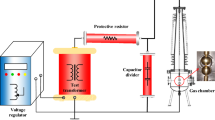Abstract
Mixing N2 into SF6 can effectively reduce the amount of SF6 used in electrical equipment. Micro-water is a common operating condition in electrical equipment, so the effect of micro-water on SF6/N2 needs to be considered before it is put into use. In this paper, the AC voltage breakdown experiments were performed on 0.5 MPa 30% SF6/70% N2 gas mixture at different concentrations and the decomposition products and breakdown voltage were quantitative analyzed. The experimental results show that when the water content exceeds 331 ppm, the content and gas production rate of SOF2 and SO2F2 increase significantly, which can affect the safety of people and equipment. There is a linear relationship between the content of H2S and the content of water inside the equipment, which can be used as a characteristic quantity to monitor the water content inside the equipment. When the water content exceeds 549 ppm, the insulation strength of the gas mixture is significantly reduced. Overall, the micro water content inside the equipment should not exceed 300 ppm.
Access this chapter
Tax calculation will be finalised at checkout
Purchases are for personal use only
Similar content being viewed by others
References
Zhang X, Wu P, Lin C et al (2021) Compatibility and interaction mechanism between EPDM rubber and a SF6 alternative gas-C4F7N/CO2/O2. ACS Omega 6:13293–13299
Tian S, Lan J, Rao X et al (2021) Study on compatibility between C6F12O/N2 gas mixture and sealing rubber material at different temperatures. J Mol Struct 1244:130949
Tian S, Lan J, Rao X et al (2022) Study on compatibility between C6F12O/N2 gas mixture and sealing rubber material at different temperatures. High Voltage Eng 48(11):4275–4286 (in Chinese)
Tian S, Liu B, Wang Y et al (2023) Adsorption performance of Cu-HfSe2 on air decomposition products: a first-principles study. Mater Today Commun 34:105400
Tian S, Zhang X, Cressault Y et al (2020) Research status of replacement gases for SF6 in power industry. AIP Adv 10(5):050702
Xiao D (2016) Development prospect of gas insulation based on environmental protection. High Voltage Eng 42(4):1035–1046 (in Chinese)
Yan X, Gao K, Zheng Y et al (2018) Progress of gas mixture and alternative gas of SF6. Power Syst Technol 42(6):1837–1844 (in Chinese)
Malik NH, Qureshi AH (1979) A review of electrical breakdown in mixtures of SF6 and other gases. IEEE Trans Electr Insul 14(1):1–13
Malik NH, Qureshi AH (1979) Calculation of discharge inception voltages in SF6–N2 mixtures. IEEE Trans Electr Insul 14(2):70–76
Tang J, Qiu Y, Zeng F et al (2012) Formation mechanism and influence rules of trace levels H2O on SF6 characteristic decomposition components under partial discharge. Trans China Electrotechnical Soc 27(10):13–19 (in Chinese)
Hergli R, Casanovas J, Derdouri A et al (2002) Study of the decomposition of SF6 in the presence of water, subjected to gamma-Irradiation or corona discharges. IEEE Trans Dielectr Electr Insul 23(3):451–465
Sauers I, Harman G (1992) A mass spectrometric study of positive and negative ion formation in an SF6 corona. II. Influence of water and SF6 neutral by-products. J Phys D Appl Phys 25(5):774
Zhong J, Wang Q, Lin X et al (2020) Study on discharge decomposition mechanism of SF6 under micro-water and micro-oxygen. High Voltage Apparatus 56(5):1–7 (in Chinese)
Xiao S, Li Y, Zhang X et al (2017) Effects of micro-water on decomposition of the environment-friendly insulating medium C5F10O. AIP Adv 7(6):065017
Yang Y, Gao K, Ding L et al (2022) Influence law of micro-water on insulation and decomposition characteristics of eco-friendly C4F7N/CO2 gas mixture. Power Syst Technol 46(6):2402–2409 (in Chinese)
Author information
Authors and Affiliations
Corresponding author
Editor information
Editors and Affiliations
Rights and permissions
Copyright information
© 2024 Beijing Paike Culture Commu. Co., Ltd.
About this paper
Cite this paper
Luo, C. et al. (2024). Influence of Micro-water on Insulation and Decomposition Characteristics of SF6/N2 Mixtures. In: Dong, X., Cai, L.C. (eds) The Proceedings of 2023 4th International Symposium on Insulation and Discharge Computation for Power Equipment (IDCOMPU2023). IDCOMPU 2023. Lecture Notes in Electrical Engineering, vol 1101. Springer, Singapore. https://doi.org/10.1007/978-981-99-7401-6_20
Download citation
DOI: https://doi.org/10.1007/978-981-99-7401-6_20
Published:
Publisher Name: Springer, Singapore
Print ISBN: 978-981-99-7400-9
Online ISBN: 978-981-99-7401-6
eBook Packages: EnergyEnergy (R0)




